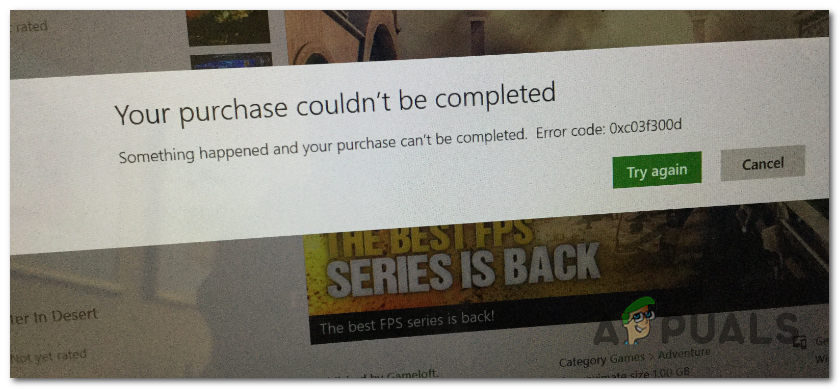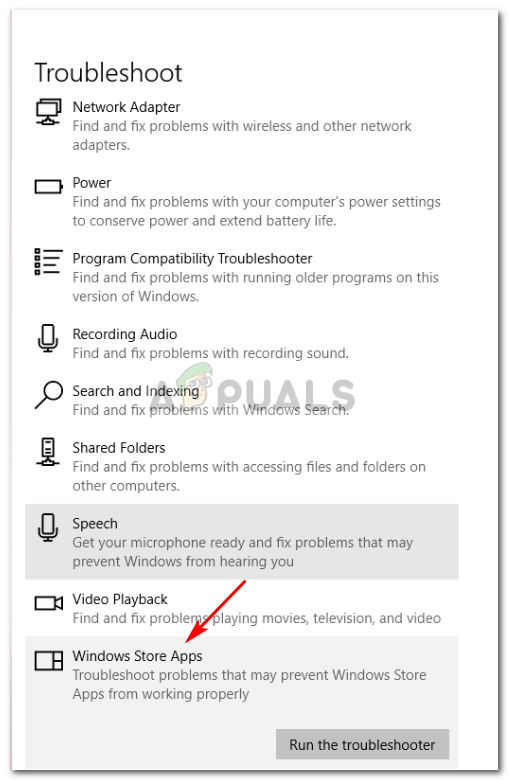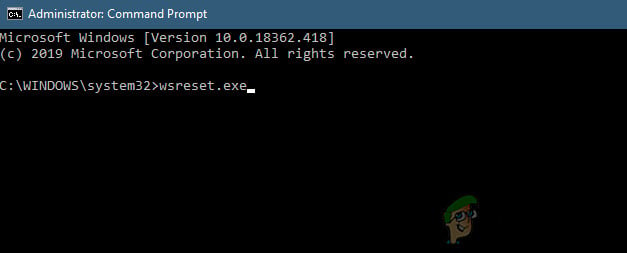How to Fix Store Error 0xc03f300d on Windows?
Several Windows 10 users have been reaching us with questions after being unable to download applications & games from the Microsoft Store. The error code that comes up is 0xc03f300d. Most affected users are saying that they can’t access their purchases even though they purchased the listing previously or the app/game is completely free. The issue seems to be exclusive to Windows 10.

What’s causing the Windows Store Error 0xc03f300d?
We investigated this particular issue by looking at various user reports and by testing out the different repair strategies that affected users have successfully used to get to the bottom of this issue. As it turns out, several different scenarios might give birth to this type of problem. Here’s a shortlist of potential culprits that might be responsible for the 0xc03f300d error:
- Windows Store glitch – As it turns out, you’re likely encountering this issue due to some kind of temporary issue that is occurring locally. If this scenario is applicable, you should be able to resolve the issue by running the Windows Store utility.
- Corrupted Cache Data. – It’s also possible that one or more corrupted files end up interrupting the connection between the UWP Store and Microsoft servers. If this happens, one cure-all would be to clear the cached data of the Store application and sign-in with your account again.
- System file corruption – Under certain circumstances, you might be encountering this issue due to some type of system file corruption. In this case, you should be able to resolve the issue by resetting every OS component with a procedure like a repair install or clean install.
Method 1: Running the Windows Store troubleshooter
Before we explore other repair strategies, let’s test to see if whether your Windows version is not able to resolve the issue automatically. If the problem is occurring due to a common inconsistency, you should be able to resolve the issue by running the Windows Store Troubleshooter.
This utility contains a selection of automated repair strategies designed to resolve the most common problems that might make Windows Store unusable. If the problem that’s causing the 0xc03f300d in your case is already covered by a repair strategy, then this utility should end up fixing the problem automatically.
Several affected users have confirmed that following the instructions below have allowed them to fix the problem indefinitely. Here’s what you need to do:
- Press Windows key + R to open up a Run dialog box. Inside the next window, type ‘ms-settings:troubleshoot’ and press Enter to open up the Troubleshoot tab of the Settings app.

Accessing the Troubleshooting tab - Once you’re inside the Troubleshooting tab, scroll down to Find and other problems section, then click on the Windows Store Apps and click on Run the troubleshooter.

Run Windows Store Apps troubleshooter - Wait until the diagnostic is complete and see if a viable repair fix gets recommended. If this happens, click on Apply this fix to enforce the recommended repair strategy.

Apply this fix - After the recommended repair strategy is enforced, restart your computer and see if the issue is resolved at the next startup.
If the 0xc03f300d error is still occurring, move down to the next method below.
Method 2: Restore the Windows Store component
Another potential scenario that is known to cause the 0xc03f300d error are some temporary files that will end up inhibiting your PC’s ability to establish connections between the integrated UWP store and Microsoft servers. In the vast majority of cases, this problem will occur due to some temporary files that are stored inside the cache folder.
This type of problem will most likely surface after the security scanner ends up quarantining some items or after an unexpected machine interruption. Both updates are another fairly popular reason that will spawn this type of problem,
If this scenario is applicable, you should be able to resolve the issue by resetting the entire Windows Store cache. There are two different methods that will allow you to do this on Windows 10.
The first option is easier, but it will require you to run a command from inside an elevated CMD terminal. If you want an exclusive GUI approach, you should follow the second approach that will allow you to operate exclusively from the Windows settings menus.
Feel free to follow whichever method is easier to your level of technical knowledge:
Resetting the Windows Store cache via an elevated CMD
- Press Windows key + R to open up a Run dialog box. Next, type ‘cmd’ inside the text box and press Ctrl + Shift + Enter to open up a Command Prompt with administrative privileges. As soon as you see the UAC (User Account Control), click Yes to grant admin access.

Opening an elevated Command Prompt from a Run dialog box - Once you’re inside the elevated Command Prompt, type the following command and press Enter to reset the Windows Store along with all dependencies:
wsreset.exe

Resetting Windows Store - Once the command is processed successfully, restart your computer and see if the issue is resolved at the next system startup.
Resetting Windows Store cache via the Settings app
- Press Windows key + R to open up a Run dialog box. Next, type ”’ms-settings:appsfeatures’ and press Enter to open up the Apps & Features menu of the Settings app.
- Once you manage to get inside the Apps & Features screen, scroll down to the list of installed UWP applications and locate the Microsoft Store entry.
- After you manage to locate Microsoft Store, click on the Advanced Option hyperlink (under Microsoft Corporation)
- When you’re inside the Advanced options menu, scroll down to the Reset button and initiate the process of clearing out the cache.
- Wait until the process is complete, then reboot your machine and check to see if the issue is resolved at the next system startup.

If the same 0xc03f300d error, is still occurring, move down to the next method below.
Method 3: Performing a repair install
If none of the instructions below have allowed you to resolve the 0xc03f300d error code, the chances of dealing with an underlying corruption issue are very high. In this case, the most efficient way of fixing the problem is to refresh every Windows component and booting-related data.
When it comes to refreshing your entire OS configuration, you can either do it via a clean install or via a repair install (in-place repair).
Doing a clean install is the easier solution, but be prepared to lose all your data if you don’t back them up in advance.
If you’re looking for a more efficient way of doing this, you should go for a repair install (in-place repair). But keep in mind that the steps of doing this are long and you will be required to insert an installation media compatible with your OS version. But the major advantage is that all your files (including apps, games and even some user preferences will remain intact.




